MONTHLY HMAR UPDATE: JUNE 2022
June was a busy month, we can’t believe it’s gone by so quickly! We’ve included some highlights from the month below, so be sure to check them out, and if you want to see the explanations for each of the numbers we report, please check the bottom of the post!
Number of Calls to HMAR – June total 464 (about 15 per day)
Of those calls: 351 were regarding monk seals, 88 about sea turtles, and 25 about seabirds. We also received a call about juvenile Hammerhead sharks on the southeast side of Oahu. May through June is the pupping season for Hammerhead sharks in Hawaii and each year we get calls about these young sharks washing up on shore. Since these animals don’t fall under our operations, we passed the information along to the Hawaii Department of Land & Natural Resources (DLNR).

 Number of Field Support Actions – June total 164 (about 5 per day)
Number of Field Support Actions – June total 164 (about 5 per day)
On average, each field support action usually involves about 4.5 hours of v olunteer or staff time, so this work collectively required hundreds of hours of work. Here are some highlights from this month! Hawaiian monk seal RK96 “Kaiwi” was reported hauled out on beaches for over half the month! Turns out she was getting ready to begin her annual molt (see picture left) when monk seals lose their pelage (fur) and the top layer of skin, to reveal a brand new coat. Now that she has begun her molt we can say Kaiwi will likely not be pupping this year. Speaking of monk seal pups, RQ64 “Laki” and RQ24 “Maka’u’ole” both officially were weaned and tagged this month (see picture right)! Both are still looking nice and chunky and are doing well on their own! Plus, we have two new pups that have been born as well, both are doing well and are still with their moms at this point, and we are currently
olunteer or staff time, so this work collectively required hundreds of hours of work. Here are some highlights from this month! Hawaiian monk seal RK96 “Kaiwi” was reported hauled out on beaches for over half the month! Turns out she was getting ready to begin her annual molt (see picture left) when monk seals lose their pelage (fur) and the top layer of skin, to reveal a brand new coat. Now that she has begun her molt we can say Kaiwi will likely not be pupping this year. Speaking of monk seal pups, RQ64 “Laki” and RQ24 “Maka’u’ole” both officially were weaned and tagged this month (see picture right)! Both are still looking nice and chunky and are doing well on their own! Plus, we have two new pups that have been born as well, both are doing well and are still with their moms at this point, and we are currently working with schools in the area for children to gift them names! In June, we continued our research work to survey the offshore islands for sea turtle nesting activity (see picture left). This project, working with the U.S. Fish & Wildlife Service, will continue throughout the summer and is important to determine how sea turtles are using the Hawaiian islands for nesting.
working with schools in the area for children to gift them names! In June, we continued our research work to survey the offshore islands for sea turtle nesting activity (see picture left). This project, working with the U.S. Fish & Wildlife Service, will continue throughout the summer and is important to determine how sea turtles are using the Hawaiian islands for nesting.
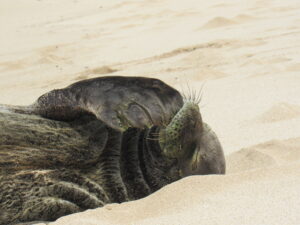 Number of Rescues, Interventions, Stranding Responses and Escalated Field Actions – June total 18 (about 1 every other day)
Number of Rescues, Interventions, Stranding Responses and Escalated Field Actions – June total 18 (about 1 every other day)
As you have likely seen, this month our team responded to the sad report of a deceased Hawaiian monk seal. We arrived on the scene and identified the seal as the well-known RE74 “Benny” (see picture left). We were able to collect and transport Benny to NOAA’s facility on Ford Island where a necropsy was performed. At this point, there has been no clear cause of death and we are awaiting tissue sample analysis. This is an incredibly sad loss for the Oahu monk seal community and we will miss seeing Benny on our beaches and the mischief he was so well known for. In addition to this extensive stranding response, we responded to a number of sea turtles and seabirds this month as well. For example, we received a call one morning about a potentially stuck or deceased sea turtle on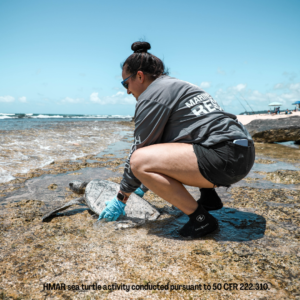 Oahu’s south shore (see picture right). Our team responded to assess the animal, when they arrived the turtle was quite dried out and exhibiting very little movement. We collected the animal and placed it in one of our rescue bins so we could perform a body condition and activity level assessment. Once in the bin, it became extremely lively and after finishing our assessment, it was released back onto the sand where it quickly moved towards the water and swam away. We believe that this sea turtle was likely basking and waiting for the tide to come back in but it was good to be able to assess it. Although we don’t often get reports of sea turtles basking in the area where this turtle was reported, this was a great reminder that our green sea turtles (honu) are beginning to bask in new locations each year! Of the 18 rescue-related actions in June, one was for Hawaiian monk seals, 12 were for sea turtles, and 5 were for seabirds. There were no cetacean (whales and dolphins) actions in June. Remember, only trained responders with proper government authority should be handling marine protected species such as sea turtles, so if you see a marine protected animal of concern, please call the NOAA marine wildlife hotline at (888) 256-9840. When you call to report an animal on Oahu or Molokai, you’ll be talking to an HMAR team member.
Oahu’s south shore (see picture right). Our team responded to assess the animal, when they arrived the turtle was quite dried out and exhibiting very little movement. We collected the animal and placed it in one of our rescue bins so we could perform a body condition and activity level assessment. Once in the bin, it became extremely lively and after finishing our assessment, it was released back onto the sand where it quickly moved towards the water and swam away. We believe that this sea turtle was likely basking and waiting for the tide to come back in but it was good to be able to assess it. Although we don’t often get reports of sea turtles basking in the area where this turtle was reported, this was a great reminder that our green sea turtles (honu) are beginning to bask in new locations each year! Of the 18 rescue-related actions in June, one was for Hawaiian monk seals, 12 were for sea turtles, and 5 were for seabirds. There were no cetacean (whales and dolphins) actions in June. Remember, only trained responders with proper government authority should be handling marine protected species such as sea turtles, so if you see a marine protected animal of concern, please call the NOAA marine wildlife hotline at (888) 256-9840. When you call to report an animal on Oahu or Molokai, you’ll be talking to an HMAR team member.

Marine Debris – More Excellent Results for June
This month, our team dove a total of four times all over the island to remove marine debris that can injure or kill marine protected animals (see picture left). From the East to the West side, we collected nearly 1,800 feet of line, cleaned about 5 acres of underwater habitat, and removed 51 animal hazards that could have hooked or entangled monk seals, sea turtles or seabirds. We also finished off our 2nd quarter BEAT DEBRIS citizen-science contest this month and selected our prize winner! Keep an eye on social media for our next contest which will be starting in July.
Number of Peo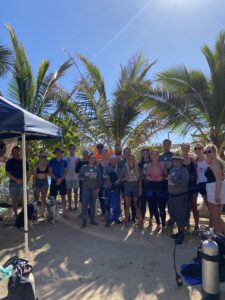 ple Reached Through Face to Face Outreach – June total 870 people
ple Reached Through Face to Face Outreach – June total 870 people
June was World Oceans Month and our Education team participated in a number of public outreach events celebrating our oceans! This month our team participated in 5 outreach events, and we talked with hundreds of people about marine protected animals, marine debris, and actions every person can take to help! One weekend this month our Education team partnered with our Marine Debris team, Aaron’s Dive Shop and Sea Life Park to host an in-water cleanup at the Makai Research Pier (see picture right). We discussed the impacts of marine debris on Hawaii’s protected species and our BEAT DEBRIS citizen-science project. It was a great turn out and we’ll definitely be hosting another one in the coming months so keep an eye out for that! In the field, we continued to do outreach talking about our monk seals, sea turtles, and seabirds!
Aaron’s Dive Shop and Sea Life Park to host an in-water cleanup at the Makai Research Pier (see picture right). We discussed the impacts of marine debris on Hawaii’s protected species and our BEAT DEBRIS citizen-science project. It was a great turn out and we’ll definitely be hosting another one in the coming months so keep an eye out for that! In the field, we continued to do outreach talking about our monk seals, sea turtles, and seabirds!
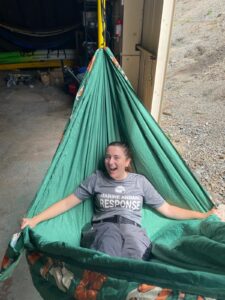
Additional News & Updates
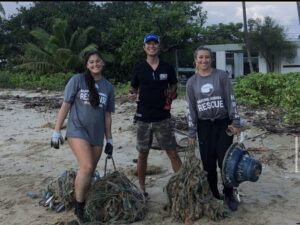
We really wanted to highlight how amazing our volunteers and interns are, and we are so lucky to have such dedicated people on our team! June was the last month for two of our long-term interns: Kelly (pictured at left) and Rui (on the left in the picture right). Kelly has been with us for over six months and this is actually her second internship with us, having been an intern the summer of 2021 as well! Kelly has handled some key activities for us and was our first stipend intern where she took over field staff shifts for us! Rui has been with HMAR for a year and has participated in each of our programs! Rui has spent most of her time in our Marine Debris and Marine Operations programs but she has done a little bit of everything. We are incredibly grateful for both of these interns who have been such an integral part of the team. We will miss them! In total, in the month of June, our volunteers and interns dedicated nearly 3,000 hours to HMAR. We are also currently in the process of training a new group of volunteers and interns as well! If you are interested in becoming a volunteer or future intern, you can find out more HERE.
Thank You!
We greatly appreciate your support of HMAR, and we couldn’t do what we do without you! If you would like to provide additional support, you can donate or volunteer today! In June, we kicked off a special fundraising campaign for a response truck. We can’t do the work we do without our trucks, and we need another truck to take the load off of our trucks that are getting old. You can make a donation to help fund another HMAR truck at https://gofund.me/a9fa074b or you can donate to our general fund HERE. That link will also lead you to our volunteer application page, and we are always looking for new volunteers!
______________________________________________________________________________
WHAT DO THESE NUMBERS MEAN?
Number of Calls – What does this mean? These are calls our hotline operators answer about any species in any situation. Whether it is a monk seal on the beach, a sea turtle of concern in the water, or a seabird that needs help. HMAR answers the calls that are made to the NOAA’s marine wildlife number for Oahu and Molokai and we take calls from the public, from the police, fire department, Ocean Safety as well as State of Hawaii agencies. Any call that comes into our hotline is reported here. Some calls result in a field response but many are valuable for animal sightings information or other data that can assist in research. Since our start in 2016, we’ve taken over 46,000 calls.
Number of Field Support Actions – What does this mean? This is when HMAR sends volunteer or staff resources into the field to perform a variety of actions in support of marine protected animals including Hawaiian monk seals, sea turtles, sea birds, dolphins, and whales. Since our start in 2016, we have had volunteers or staff in the field over 21,000 times.
Number of Rescues, Interventions, Stranding Responses and Escalated Field Actions – What does this mean? This number includes any field response that goes above and beyond a typical resting monk seal response. This includes responding to a seal of concern, an entangled, hooked, or injured sea turtle, a seabird in need of medical support, and other situations. Since 2016, we have performed over 1,700 of these actions.
Marine Debris Work – Each week our marine debris team removes underwater entanglement hazards (net, line, hooks) from high fishing pressure areas to reduce animal entanglements, hookings, injuries and death of protected marine animals. Since we started our underwater removal activities, we’ve removed more than 3,000 animal hazards, cleaned over 180 acres of underwater habitat, and we have collected many many miles of monofilament fishing line. Taking all of this debris out of underwater habitat helps save Hawaiian monk seals, sea turtles, and seabirds.
Number of People Reached through Face to Face Outreach – What does this mean? HMAR’s different program activities put our volunteers and staff in direct contact with Hawaii’s residents and visitors. Educating people about Hawaii’s marine protected species and our ocean ecosystem is one of our highest priorities and has an important impact on reducing threats. This number includes outreach done on the beaches as well as the work our Education and Engagement team does going to classes and community outreach events. Since our start we’ve reached over 270,000 people.
